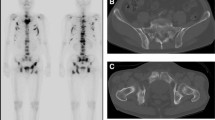Summary
Bone scintigraphy has improved greatly since the introduction of bone-seeing short-lived radionuclides. The main field of interest is the search for metastases into bone. The uncharacteristic accumulation of radiopharmaceutical agents in different bone lesions makes specific diagnostic evaluations unlikely. With careful selection of cases, however, scintigraphy can also be used in primary bone tumors as a supplementary means of diagnosis as well as having a positive effect on treatment. Clinical examples are presented to demonstrate the range of application of bone scintigraphy.
Zusammenfassung
Seit Einführung kurzlebiger osteotroper Radionuklide hat die Knochenszintigraphie wesentlich an Bedeutung gewonnen. Da anhand von Speichererhöhung im Szintigramm keine differential-diagnostischen Aussagen gemacht werden können, ist das Hauptanwendungsgebiet die Suche nach Knochenmetastasen. Unter überlegter Indikationsstellung kann jedoch auch bei primären Knochentumoren die Szintigraphie sowohl die Diagnostik ergänzen als auch die Therapieplanung positiv beeinflussen. Anhand von klinischen Beispielen werden die Anwendungsbereiche der Skeletszintigraphie aufgezeigt.
Similar content being viewed by others
Literatur
Bessler, W.: Szintigraphische Untersuchungen bei tumorösen Knochenerkrankungen. Helv. chir. Acta40, 29 (1973)
Dreyer, J., Georgi, P.: Möglichkeiten und Grenzen der Skelettszintigraphie für die Orthopädie. Stuttgart: Thieme 1972
Dreyer, J., Becker, W., Georgi, P.: Die klinische Bedeutung der Skelettszintigraphie. Therapiewoche23, 1491 (1973)
Georgi, P., Dreyer, J., Clorius, J.: Grundlagen der Skelettszintigraphie. Therapiewoche23, 1482 (1973)
Georgi, P.: Die Knochenszintigraphie — methodische Grundlagen und klinische Indikation. Röntgen-Bl.27, 475 (1974)
Georgi, P.: Szintigraphischer Nachweis von Knochenmetastasen. Diagnostik7, 715 (1974)
De Marzi, S., Masi, R., Brochi, A.: Primäry bone tumor scanning with Mercury-197. J. Nucl. Biol. Med.15, 33 (1971)
McNell, B. J., Cassady, J. R., Geiser, C. F., Jaffe, N., Fraggis, D., Treves, S.: Fluorine-18 bone scintigraphy in children with osteosarkoma or Ewing-sarcoma. Radiology109, 627 (1973)
Okuyama, S., Ito, Y., Awano, T., Sato, T.: Prospects of 67-Ga scanning in bone neoplasms. Radiology107, 123 (1973)
Wanken, J. H., Eyring, E. H., Samuels, L. D.: Diagnosis of padiatric bone lesions: correlation of clinical, roentgenographic, 87m - Sr scan, and pathologic diagnosis. J. nucl. Med.14, 803 (1973)
Author information
Authors and Affiliations
Rights and permissions
About this article
Cite this article
Georgi, P., Becker, W. 38. Knochengeschwülste: Nuklearmedizinische Diagnostik. Langenbecks Arch Chiv 339, 321–326 (1975). https://doi.org/10.1007/BF01257524
Issue Date:
DOI: https://doi.org/10.1007/BF01257524




